Whole-farm returns show true profitability of three different livestock management systems
J. F. Scott A D , J. M. Scott B and O. J. Cacho CA NSW Trade and Investment, 4 Marsden Park Road, Calala, NSW 2340, Australia.
B University of New England, School of Environmental and Rural Science, Armidale, NSW 2351, Australia.
C University of New England, School of Economics, Armidale, NSW 2351, Australia.
D Corresponding author. Email: fiona.scott@industry.nsw.gov.au
Animal Production Science 53(8) 780-787 https://doi.org/10.1071/AN11248
Submitted: 20 October 2011 Accepted: 20 March 2012 Published: 10 July 2013
Journal Compilation © CSIRO Publishing 2013 Open Access CC BY-NC-ND
Abstract
On the New South Wales Northern Tablelands, sheep, wool and beef cattle production account for most agricultural output. The industries have been challenged in recent years by environmental and economic factors and are therefore looking for modified or alternative livestock management systems that are capable of sustaining profitability. The Cicerone Project aimed to address these issues by comparing three different grazing and pasture improvement systems. Some recent livestock industry analyses have been based on gross margins which do not include overhead costs. This is an important limitation; economic analysis needs to report key whole-farm business performance measures since overhead costs can differ significantly between livestock management systems. A representative farm approach was used to compare the profitability of the three different livestock management systems. Commercial-scale whole-farm and cash flow analyses over a 5-year period were used to evaluate profitability. No particular system could be recommended to graziers because the test period was not sufficiently representative of the long-term climate to make an adequate assessment about their long-term profitability. Nevertheless, it is apparent that whole-farm level budgets are essential for comparing the overall profitability of different livestock management systems. It is concluded that analysts, consultants and graziers should use whole-farm and cash flow analyses to gauge profitability of different livestock management systems particularly where sustainability issues are important.
Introduction
It has been argued that an economic analysis calculated solely at the enterprise level cannot provide whole-business benchmarks and that it needs to be combined with whole-farm business analysis to create a comprehensive business plan (Ronan and Cleary 2000; Malcolm 2001). Some recent analyses of the sheep industry have relied entirely on gross margins (Hassall and Associates 2004) which, by definition, are not capable of measuring overall business performance. Moreover it is essential to consider financial (cash flow) feasibility over several years as well as annual whole-farm rates of return if a financial analysis is to be accurate. For example, cash flow analysis over a 10-year period was used to assess the economic impacts of several grazing management and sown pasture treatments under the Sustainable Grazing Systems National Experiment (Barlow et al. 2003). This approach supplied information that was useful to farmers in that it helped to demonstrate business viability.
In 2001, the livestock industries (mainly sheep, wool and beef cattle production) accounted for over 89% of the value of agricultural production on the Northern Tablelands of New South Wales (NSW), Australia (Alford et al. 2003). In recent years, there has been increasing attention on the sustainability of livestock enterprises across the high rainfall zone (>600 mm average annual rainfall) of southern Australia (Mason et al. 2003). Some of the factors influencing the region include the effects of climatic variability on production, commodity price variability on economic returns, declining pasture productivity, dryland salinity and soil acidity (Alford et al. 2003).
The Cicerone Project, funded by the Woolmark Co. (later Australian Wool Innovation), was formed in 1998 to investigate the continuing profitability and sustainability of grazing enterprises (Sutherland et al. 2013). After conducting a survey of graziers in the region to determine their most serious problems (Kaine et al. 2013), a whole-farmlet research trial was planned (Scott et al. 2013c) and conducted at the CSIRO research station ‘Chiswick’, near Uralla, NSW from July 2000 to December 2006. Three different systems of pasture input and grazing management of particular relevance to livestock producers on the Northern Tablelands of NSW were examined (Scott et al. 2013b). Three ‘farmlets’, each of 53 ha, were used to compare different grazing management systems and levels of pasture inputs. These treatments were determined by the Cicerone Board, which was made up of a majority of local graziers as well as researchers, extension specialists and a consultant.
In order to translate the results from the Cicerone Project farmlets to information that is useful for growers at the whole-farm scale, it was necessary to undertake a whole-farm business analysis that included key business performance measures such as business return and rates of return on assets and liabilities. Different budgeting techniques were used to analyse profitability over the 2000–01 to 2004–05 financial years. The analyses began with gross margins at the farmlet and a representative commercial scale, followed by annual whole-farm budgets and cash flows at the commercial scale to ascertain the key business performance measures.
Methods
The Cicerone Project
Following a survey to identify the key problems of concern to producers on the Northern Tablelands of NSW (Kaine et al. 2013), the Cicerone Project was set up as a producer-led ‘research and adoption’ group in 1998 with initial funding support from the Woolmark Co. The project aimed to fill the perceived gap between small-scale component research and practical whole-farm enterprises. Research was planned on a scale that was considered relevant and credible to farmers in that it could capture whole-farm interactions between pastures and livestock under different management strategies. The approach taken by the Cicerone Project was to assess issues such as sustainability and management for ongoing profitability at a whole-farm level, but also to produce conclusions on a scale relevant to farmers to facilitate adoption of improved technologies (Sutherland et al. 2013).
After considerable planning, the Cicerone Project farmlets were established in 2000 to investigate issues relating to dry seasons, fertiliser use, pasture composition and pasture persistence, and to examine management techniques that were likely to improve the resilience, stability and longevity of pastures in the region. Three farmlets of 53 ha each were set up to compare the profitability and sustainability of three different farm management systems differing in grazing management and input levels, with the specifications and goals for each farmlet determined in conjunction with producer members. Farmlet A had eight paddocks with high inputs of sown pastures and high soil fertility [target phosphorus (P) and sulfur (S) levels of 60 and 10 mg/kg, respectively] and used flexible rotational grazing in an eight-paddock system. Farmlet B had a moderate level of pasture renovation and moderate soil fertility target of 20 and 6.5 mg/kg of P and S, respectively, with the same grazing method and number of paddocks as Farmlet A. Farmlet C aimed at the same moderate level of pasture renovation and soil fertility as Farmlet B but was managed with an intensive rotational grazing system. Farmlet C started with 17 paddocks, which were later subdivided into 37 subpaddocks resulting in higher fencing costs (Scott et al. 2013b). Further details of the grazing management treatments have been provided by Scott et al. (2013b) while details of the different stocking rates and the graze-rest periods achieved have been reported by Hinch et al. (2013).
Although the farmlets were not replicated, the land allocated to them was surveyed and classified into equivalent areas according to soil type, topography and fertiliser history in a manner that was shown to be unbiased (Scott et al. 2013c). According to Murison and Scott (2013), the differences between the farmlets which developed over time were more likely to have been due to treatment effects than due to bias or random error.
The rate of pasture improvement on Farmlet A (average of 20% of farmlet area per year) was high, being well above the range from the 2000 to 2001 Agricultural Census of 4.6–13% per farm (ABS 2002). The Cicerone Board decided to adopt this higher-than-average rate of pasture improvement on Farmlet A in order to quickly differentiate the farmlet treatments by rapidly increasing the level of sown pastures, given that initial funding was limited to 5 years. Together with the increased stocking rate supported by Farmlet A, the increased rate of pasture renovation resulted in high grazing pressure on the remaining pastures. In addition, an early decision to trial two paddocks of short-term biennial ryegrass, both of which needed re-sowing within 2 years, meant that these two paddocks were sown twice during the 5-year period (Scott et al. 2013b).
Data sources
A relational database with the ability for queries to be conducted over the Internet was set up as part of the project to be a central reference point for Cicerone data outputs. Records from the database used in this study included production results such as livestock weights and wool production and quality per head as well as livestock inputs such as drenches, vaccines and purchased supplementary feed. Records of livestock purchases and sales, as well as variable costs such as shearing, marking, livestock selling and wool selling costs were used as inputs for the various economic analyses.
Inputs relevant for economic analysis of each farmlet were collected (Table 1) from database reports. Details of the pasture and livestock inputs have been reported in a companion paper, which presents the overall farmlet methods and experimental guidelines (Scott et al. 2013b). This enabled reporting of farmlet-scale costs but also calculation of input costs at the commercial scale. Also, the month when each input occurred was recorded, which enabled calculation of cash flow statements on a monthly basis.
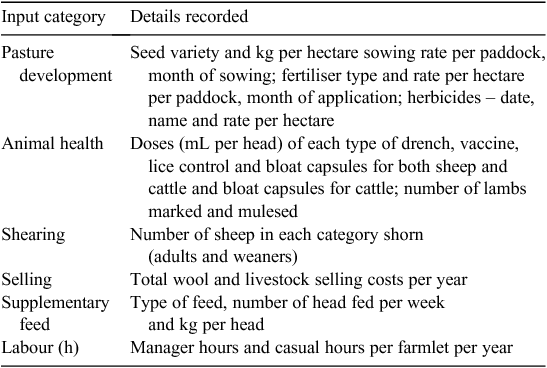
|
Commercial-scale assumptions
The aim of the project was to enhance adoption of more profitable and sustainable grazing enterprises; an appraisal of the commercial-scale factors would enable producers to compare the Cicerone research results at a scale relevant to the farms they operate. A recent report on typical livestock farming systems on the Northern Tablelands of NSW described a representative farm in the region as consisting of 920 ha (Alford et al. 2003). The farm area selected by Alford et al. (2003) was the size of the average agricultural establishment on the Northern Tablelands according to the 1996–97 Australian Bureau of Statistics Agricultural Census. The representative farm size and overhead costs from Alford et al. (2003) were used in this analysis since the data were from a relevant time period, just before commencement of the Cicerone farmlet operations in 2000.
Economic and financial analysis methods
Livestock trading schedules and activity gross margins were constructed for the three Cicerone farmlets using financial year data for the 5 years from 2000–01 to 2004–05. Pasture and fencing costs were not included at the activity level since the returns from pasture improvement and grazing management changes due to investment in fencing, occur over several years, so they were not attributed to one activity in one year. These costs were therefore treated as ‘indirect’ (or overhead costs) at the whole-farm level.
Livestock trading schedules and activity gross margins were also constructed at the commercial scale for 2000–01 to 2004–05. The commercial-scale gross margins were not simply linear extrapolations from the farmlet scale. Some figures such as livestock numbers could be scaled up by a simple factor based on the ratio of farm : farmlet area (17.03) but others had to be adjusted to avoid scaling errors. This included using commercial-scale pricing for shearing, selling and marketing costs, bulk fertiliser and pesticide costs and bulk supplementary feed costs. Annual whole-farm budgets were then prepared at the commercial scale to determine key annual profitability measures such as operating and business return and operating return on assets and business return on equity (Malcolm et al. 2005). In order to do this, Assets and Liabilities Balance Statements and Profit and Loss Statements for each year were constructed. Cash flow statements were prepared for each of the three commercial-scale farms to incorporate the cash flow effects of casual labour and capital expenditure on fencing and pastures, and to observe peak debt levels. This also enabled monthly interest figures on loans and/or overdrafts to be calculated.
Results
Total farm gross margins at the commercial scale are shown in Table 2. Following standard practice, hired labour was not included in the commercial-scale gross margins but it was accounted for in the whole-farm budgets.
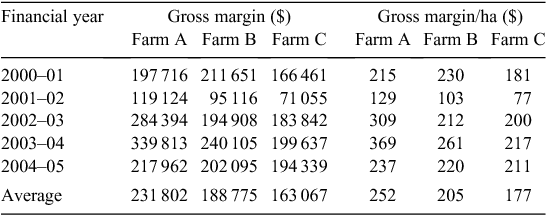
|
Farm A (intensive pasture improvement) had the highest gross margin returns, followed by Farm B (‘typical’ local practice). Farm C (intensive rotational grazing) had the lowest gross margin returns. In contrast, Farm A had the lowest whole-farm returns, whereas whole-farm returns throughout the 5 years for Farm B remained positive with the highest whole-farm returns overall. Farm C had slightly lower whole-farm returns than Farm B. The average gross margin for Farm A was $251.96/ha, which was $46.77/ha higher than that of Farm B ($205.19/ha). Farm B average gross margin was $27.94/ha above that for Farm C ($177.25/ha).
Gross margin differences were driven in part by the higher stocking rate on Farm A, resulting in higher total wool yield and trading livestock income. Farm A variable costs were also higher than for Farm B, but Farm A extra income more than made up for this. Farm A had a higher average farm gross margin and cumulative total gross margin than Farm B, due to both higher wool and cattle trading gross margins. Farm C had a lower farm gross margin than Farm B, principally due to lower wool enterprise returns. Although Farm C had slightly better cattle trading returns than Farm B, this was not enough to make up for the difference in wool enterprise returns.
Cumulative whole-farm gross margins are shown in Fig. 1. The results are similar to those at the farmlet scale. Farms A and B returns were very similar until 2002–03, when the higher productivity of Farm A resulted in higher returns. Farm C returns remained lower than Farm B returns throughout the period of analysis.
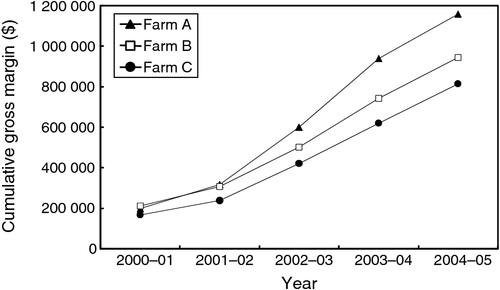
|
A summary of the commercial-scale annual whole-farm results is shown in Table 3. Business return represents whole-farm returns after deduction of overhead costs, owner-operator allowance and costs of finance (interest and fees). Closing equity is a measure of an owner’s business equity (the percentage of asset value they would receive if the property was sold) at the end of each financial year.

|
Farm B maintained positive whole-farm returns and 100% closing equity in each of the 5 years analysed. Farm A had negative business returns in 2000–01 and 2001–02, but returned to positive business returns in the last 3 years. Farm A had a higher business return than Farm B in 2002–03 and 2003–04 but lower in 2004–05. The heavy borrowings required by Farm A for sown pastures resulted in the early negative returns and a decline in equity. As the business return for Farm A recorded positive levels in 2002–03 to 2004–05, equity also began to recover. Farm A return on assets and business return suffered a downturn in 2004–05 due largely to high supplementary feeding costs in that year.
Farm C also had negative business returns in 2000–01 and 2001–02, due to lower productivity and the extra expenses incurred in fencing the many small paddocks. Farm C only had better returns than Farm B in 1 year (2002–03), and both had similar returns in 2004–05. Both had lower returns in 2004–05 than in 2003–04 due to several factors including lower rainfall, lower income and higher supplementary feeding costs.
High supplementary feeding costs were a result of below-average rainfall during the study period resulting in poor pasture growth, and the management decision to try to maintain stocking rates at or near target levels.
The business return standard deviation figures in Table 3 show that Farm B had lower business return variability than either Farm A or Farm C. The mean and standard deviation figures are illustrated in Fig. 2. This comparison is based on the mean standard deviation efficiency (or mean – variance efficiency) rule described by Hardaker et al. (2004). In this context, strategy B would be generally preferred to the other two strategies because it has higher returns and lower variability. Strictly speaking, the dominance of B over C and A can only be unambiguously declared after testing for stochastic dominance, which involves comparing the whole probability distributions for the different options; this is done in a related paper by Scott et al. (2013a). Notwithstanding the strict definition of dominance, from a practical standpoint, Fig. 2 is useful because it shows potential trade-offs between returns and risks (Hardaker et al. 2004).
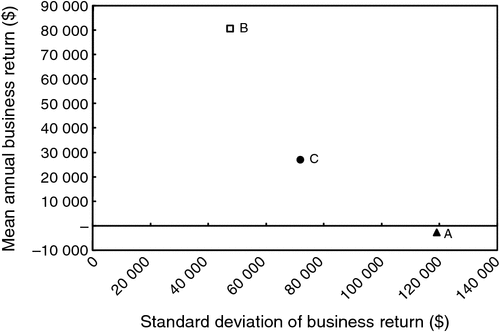
|
Monthly cash flow statements were prepared for each commercial-scale farm. All farms were assumed to be starting from a zero balance position. The ‘end of financial year’ cash position for each farmlet is shown in Table 4. Farm A reached its peak overdraft of $415 000 in December 2004. This was due in part to the cumulative effect of the previous 4.5 years but also due to a $126 000 purchase of cattle in December 2004. Farm B reached its peak overdraft in July 2000, due to no income but some expenses occurring in this month. Farm C reached its peak overdraft in July 2000 for the same reason as for Farm B. The Farm C overdraft was larger due to both water infrastructure and fencing expenses being covered in the overdraft account.
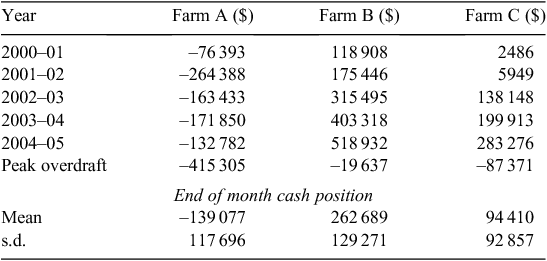
|
Farm A and Farm B monthly cash flows are compared in Fig. 3. The same pattern of peaks and troughs occurred due to wool income every August and livestock (both sheep and cattle) buying and selling. Farm A had a declining trend due to continuing large pasture improvement costs, which totalled ~$507 000 over the 5-year period. Even though Farm A had higher gross margins than Farm B, the level of pasture expenditure for Farm A far outweighed any gains in terms of animal productivity compared with Farm B. A great deal of variation between years on all farms was due to livestock trading with large expenditures on purchased stock and large income from sale stock, especially in 2002–03. A large part of this variability was due to cattle trading.
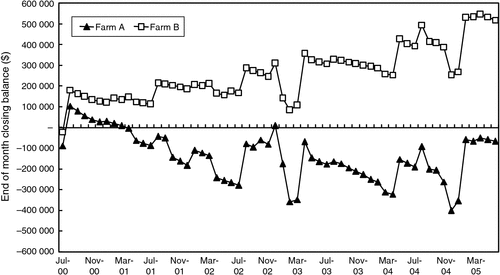
|
Farm C and Farm B monthly cash flows are compared in Fig. 4. Farm C started with a higher level of debt than Farm B, due to infrastructure expenses, and also had slightly higher total farm costs and lower overall whole-farm gross margin than Farm B. Thus returns from Farm C were not enough to make up for its higher starting debt and higher costs, so its cash flow remained behind that of Farm B.
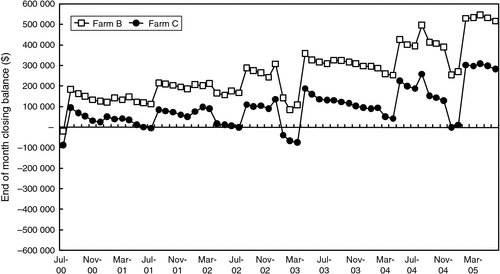
|
The mean and standard deviation figures for cash flow are illustrated in Fig. 5. Farm C had the lowest variability as measured by the standard deviation of the results for business return. In this case Farm C dominated Farm A. Farm C also had a lower standard deviation than Farm B; however, Farm B had a higher average closing balance. So Farm C may be appropriate for a producer who is averse to negative returns and is willing to forgo some income to reduce their risk.
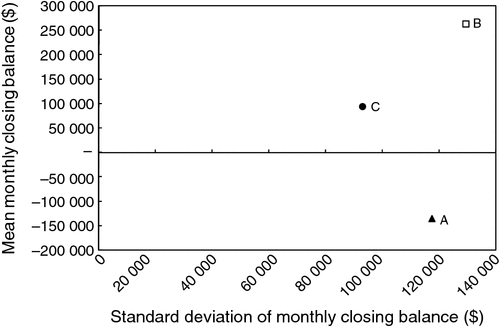
|
Discussion
When the farms are ranked according to gross margin returns over the 5-year period analysed, Farm A ranks first, followed by Farm B and then Farm C. However, when the farms are ranked in terms of business returns, Farm B ranks first, followed by Farm C and then Farm A. These contrasting results support the suggestion by Malcolm et al. (2005) that annual activity gross margins alone cannot indicate the profitability of an investment. Activity gross margins are necessary to begin the assessment process, however, where capital investments are involved, measures of business return on capital, gearing and liquidity are also needed (Malcolm 2001). These results also show that using production outcomes as proxies for profitability is incorrect (also stated by Malcolm and Ferris 1999; Ronan and Cleary 2000). For instance, Farm A produced more wool and beef per hectare than either Farm B or C; however, it resulted in the lowest average business return over the analysis period.
Farm A had poor returns in the first 2 years in terms of key business performance measures such as return on assets, net cash flow (i.e. liquidity) and equity change (i.e. growth). However, even though cash flow remained negative, business return for a commercial-scale Farm A would have returned to positive levels in 2002–03 and 2004–05, with equity levels gradually building back up from a low of 82% in 2001–02. At the end of the 5-year period, the representative Farm A had returned to 92% equity but still had an overdraft. Although Farm A cash flows remained well behind those of Farms B and C, Farm A did not become insolvent [a business becomes insolvent when liabilities are greater than the value of assets (Malcolm et al. 2005)]. Therefore, the possibility remains that in future years Farm A could continue to generate positive business returns and recover to 100% equity, especially if some of those years received higher rainfall than the below-average rainfall years experienced between 2000 and 2006 (Behrendt et al. 2013b). This would be dependent on grazing management permitting the more digestible and productive sown pastures to persist and pasture improvement costs reducing compared with the first 5 years. Modelling can assist with estimation of these systems under a longer time frame as described by Behrendt et al. (2006, 2013a).
The high capital costs of pasture improvement for Farm A were not covered by the increase in productivity and income between 2000 and 2005. This was due to the below-median conditions for plant-available water for the whole period (Behrendt et al. 2013b), constraining the growth potential of Farm A pastures. However, since Farm A did not reach insolvency level, a commercial-scale enterprise could have kept trading in spite of a large peak overdraft.
The goal of 100% sown species on Farm A was not reached during the experimental period because the grazing pressure the paddocks were subjected to, coupled with below-average rainfall, allowed less desirable (lower digestibility) pasture species to remain in the pasture sward (Shakhane et al. 2013b). The level of pasture improvement and soil fertility level reached on Farm A meant that, given sufficient rainfall, it had the potential to provide pasture growth above animal needs. This meant that there was the potential for fodder conservation (such as hay or silage), which could offset the costs of supplementary feed when pasture growth was inadequate to meet nutritional needs. Again, due to lack of rainfall, silage was unable to be made on Farm A until December 2005, which was outside the period of analysis. In December 2005, 160 round bales of silage were made from Paddock A1 pastures (3.8 ha) of mature phalaris, lucerne and chicory (Scott et al. 2013b). This illustrates the potential for Farm A to reduce future purchased feed costs.
In addition, there were low proportions of pasture legumes across all three farmlets, with the average legume percentage never getting above 10% (Shakhane et al. 2013a). As Farmlet A livestock numbers and average liveweights were higher (Hinch et al. 2013), Farmlet A had more periods of feed shortages than Farmlets B or C (Shakhane et al. 2013c). Farmlet C was able to maintain a higher level of desirable pasture species composition than Farmlet B; however, Farmlet C had a consistently low legume percentage (Shakhane et al. 2013b). The lower returns for Farmlet C were partly due to the grazing rest period being too long, with high stocking densities (Scott et al. 2013b) resulting in lower liveweights for both sheep and cattle (Hinch et al. 2013) and lower wool cut per head for sheep (Cottle et al. 2013).
The cash flow analysis showed a great deal of variability between months and between years. Much of the variability was due to livestock trading, especially cattle. The issue arises of how realistic an example this was – would growers in the real world incur these kinds of costs? While an industry survey of the kind required to answer this question was beyond the scope of this study, an example of livestock trading of this magnitude has recently been documented. In a study by Land and Water Australia (2004) made up of three properties (totalling 1297 ha) near Glen Innes, ~600 head of weaner cattle were purchased annually (between May and June each year) to be grown out over a 9–12-month period (Land and Water Australia 2005b). The figures from this case study can be used as an example to estimate the appropriateness of the financial-scale calculations of the Cicerone full-scale farms as follows: 600 weaner cattle weighing ~240 kg per head and costing $2.00 per kg liveweight would cost $288 000. The same number of cattle sold at 450 kg per head at $1.90 per kg liveweight would return $513 000. These are similar levels of cattle trading costs and income to those for the commercial-scale versions of the Cicerone farms.
Given that a commercial-scale Farm A showed a positive business return in the latter 3 years analysed, given some good seasons, it could return to positive cash flow levels and generate improved business returns. The scenario analysis for the commercial-scale Farm A has shown that it does have the potential to realise good returns, however there is a higher level of variability of returns associated with the Farm A approach.
A commercial-scale Farm B performed the best in terms of whole-farm profitability to the end of June 2005, but its profitability may decline over time due to the decline in digestible pasture species that was documented over the 5 years of the study. This farm has much less ability to take advantage of ‘good’ seasons, due to a lower stocking rate, lower soil fertility and sown pasture inputs, and lower legume content thus limiting the ability of pastures and subsequent animal production to respond to higher rainfall seasons. This is a lower risk system in terms of variability and is less intense in terms of management and capital inputs compared with a Farm A system. However, due to the decline in digestible pasture species, its longer-term sustainability is under question. The funding of longer-term research and monitoring of key indicators would assist in assessing the sustainability of alternative grazing systems.
The commercial-scale profitability of Farm C may be improved with some better seasons but also may require some alterations to grazing management to enable livestock access to pasture before it becomes too mature and less digestible. While there are documented examples where growers feel they have successfully implemented similar ‘intensive rotational grazing’ approaches (Land and Water Australia 2005a, 2005c) there remains considerable dispute about the benefits of such approaches (Waugh 1997; Norton 1998).
The Cicerone Project was designed to assess management techniques which would improve resilience, stability and longevity of pastures, and therefore farm businesses in the region. Some of the aspects of this assessment to date have been inconclusive, since the climatic conditions over the analysis period have not sufficiently tested the potential of the different treatments. Measurements of resources such as soils and pastures have shown that, over a longer term, the possibility remains that Farm B may experience productivity decline and perhaps encounter resource degradation issues due to its declining pastures (Shakhane et al. 2013b). It may be that Farms A and C might be capable of better capturing the advantages of above-average rainfall.
Lastly, an issue has come to light regarding the validity of comparing results from the Farm A and B treatments directly. Recent research by Behrendt et al. (2006) using simulation modelling has estimated that Farm A and B are not directly comparable because Farm A has not been operating on the risk-efficient frontier. This issue is explored in a subsequent paper by Scott et al. (2013a).
Acknowledgements
The authors wish to thank the members, team and Board of The Cicerone Project Inc. for making data available, in particular the contribution of Caroline Gaden (Cicerone Project Executive Officer), Justin Hoad (Cicerone Project Farm Manager) as well as Dion Gallagher and Colin Lord of the Relational Database Unit, University of New England. The Cicerone Project was supported by Australian Wool Innovation. The authors would like to thank Dr Rob Brown, Write Way Consulting, for comments on a previous draft of this paper.
References
ABS (2002) ‘Australian agricultural census 2001.’ (Australian Bureau of Statistics: Canberra)Alford AR, Griffith GR, Davies LD (2003) Livestock farming systems in the Northern Tablelands of NSW: an economic analysis. NSW AgricultureEconomics Research Report 12, Orange.
Barlow R, Ellis NJS, Mason WK (2003) A practical framework to evaluate and report combined natural resource and production outcomes of agricultural research to livestock producers. Australian Journal of Experimental Agriculture 43, 745–754.
| A practical framework to evaluate and report combined natural resource and production outcomes of agricultural research to livestock producers.Crossref | GoogleScholarGoogle Scholar |
Behrendt K, Cacho O, Scott JM, Jones R (2006) Methodology for assessing optimal rates of pasture improvement in the high rainfall temperate pasture zone. Australian Journal of Experimental Agriculture 46, 845–849.
| Methodology for assessing optimal rates of pasture improvement in the high rainfall temperate pasture zone.Crossref | GoogleScholarGoogle Scholar |
Behrendt K, Cacho O, Scott JM, Jones R (2013a) Optimising pasture and grazing management decisions on the Cicerone Project farmlets over variable time horizons. Animal Production Science 53, 796–805.
| Optimising pasture and grazing management decisions on the Cicerone Project farmlets over variable time horizons.Crossref | GoogleScholarGoogle Scholar |
Behrendt K, Scott JM, Mackay DF, Murison R (2013b) Comparing the climate experienced during the Cicerone farmlet experiment against the climatic record. Animal Production Science 53, 658–669.
| Comparing the climate experienced during the Cicerone farmlet experiment against the climatic record.Crossref | GoogleScholarGoogle Scholar |
Cottle D, Gaden CA, Hoad J, Lance D, Smith J, Scott JM (2013) The effects of pasture inputs and intensive rotational grazing on superfine wool production, quality and income. Animal Production Science 53, 750–764.
| The effects of pasture inputs and intensive rotational grazing on superfine wool production, quality and income.Crossref | GoogleScholarGoogle Scholar |
Hardaker JB, Huirne RBM, Anderson JR, Lien G (2004) ‘Coping with risk in agriculture.’ (CAB International: Wallingford, UK) 332 pp.
Hassall and Associates (2004) Comparing Merino sheep enterprise profitability. Australian Farm Journal 17–21.
Hinch GN, Hoad J, Lollback M, Hatcher S, Marchant R, Colvin A, Scott JM, Mackay D (2013) Livestock weights in response to three whole-farmlet management systems. Animal Production Science 53, 727–739.
| Livestock weights in response to three whole-farmlet management systems.Crossref | GoogleScholarGoogle Scholar |
Kaine G, Doyle B, Sutherland H, Scott JM (2013) Surveying the management practices and research needs of graziers in the New England region of New South Wales. Animal Production Science 53, 602–609.
| Surveying the management practices and research needs of graziers in the New England region of New South Wales.Crossref | GoogleScholarGoogle Scholar |
Land and Water Australia (2004) What do native vegetation, quality wool and healthy profits have in common in the Northern Tablelands of NSW? Research Project: Northern Tablelands NSW ‘Profitable Wool Production & Biodiversity”. (Eds K Forge, N Reid) (Land & Water Australia: Canberra)
Land and Water Australia (2005a) ‘Case study: wool production and biodiversity working together for Jon and Vicki Taylor.’ (Land & Water Australia: Canberra)
Land and Water Australia (2005b) ‘Case study: wool production and biodiversity working together for Rob and Annabel Dulhunty.’ (Land and Water Australia: Canberra)
Land and Water Australia (2005c) ‘Case study: wool production and biodiversity working together for Tim and Karen Wright.’ (Land & Water Australia: Canberra)
Malcolm B (2001) Farm management economic analysis: a few disciplines, a few perspectives, a few figurings, a few futures. Paper 42. In ‘Agribusiness Perspectives’. Available at: http://www.agrifood.info/perspectives/2001/Malcolm.html [Verified 9 August 2012]
Malcolm B, Ferris A (1999) ‘Benchmarking benchmarking.’ (University of Melbourne, Department of Food Science and Agribusiness: Melbourne)
Malcolm B, Makeham JP, Wright V (2005) ‘The farming game: agricultural management and marketing.’ (Cambridge University Press: Melbourne)
Mason WK, Lamb K, Russell B (2003) The Sustainable Grazing Systems Program: new solutions for livestock producers. Australian Journal of Experimental Agriculture 43, 663–672.
| The Sustainable Grazing Systems Program: new solutions for livestock producers.Crossref | GoogleScholarGoogle Scholar |
Murison R, Scott JM (2013) Statistical methodologies for drawing causal inference from an unreplicated farmlet experiment conducted by the Cicerone Project. Animal Production Science 53, 643–648.
| Statistical methodologies for drawing causal inference from an unreplicated farmlet experiment conducted by the Cicerone Project.Crossref | GoogleScholarGoogle Scholar |
Norton BE (1998) The application of grazing management to increase sustainable livestock production. In ‘Animal production in Australia’. Available at http://www.asap.asn.au/livestocklibrary/1998/MCCMONT.PDF [Verified 18 June 2012]
Ronan G, Cleary G (2000) Best practice benchmarking in Australian agriculture: issues and challenges. In ‘44th Annual Conference of the Australian Agricultural and Resource Economics Society’. Available at http://ageconsearch.umn.edu/bitstream/123728/2/Ronan.pdf [Verified 9 August 2012]
Scott JF, Cacho OJ, Scott JM (2013a) Economic risk analysis of livestock management system options. Animal Production Science 53, 788–795.
| Economic risk analysis of livestock management system options.Crossref | GoogleScholarGoogle Scholar |
Scott JM, Gaden CA, Edwards C, Paull DR, Marchant R, Hoad J, Sutherland H, Coventry T, Dutton P (2013b) Selection of experimental treatments, methods used and evolution of management guidelines for comparing and measuring three grazed farmlet systems. Animal Production Science 53, 628–642.
| Selection of experimental treatments, methods used and evolution of management guidelines for comparing and measuring three grazed farmlet systems.Crossref | GoogleScholarGoogle Scholar |
Scott JM, Munro M, Rollings N, Browne W, Vickery PJ, Macgregor C, Donald GE, Sutherland H (2013c) Planning for whole-farm systems research at a credible scale: subdividing land into farmlets with equivalent initial conditions. Animal Production Science 53, 618–627.
| Planning for whole-farm systems research at a credible scale: subdividing land into farmlets with equivalent initial conditions.Crossref | GoogleScholarGoogle Scholar |
Shakhane LM, Mulcahy C, Scott JM, Hinch GN, Donald GE, Mackay DF (2013a) Pasture herbage mass, quality and growth in response to three whole-farmlet management systems. Animal Production Science 53, 685–698.
| Pasture herbage mass, quality and growth in response to three whole-farmlet management systems.Crossref | GoogleScholarGoogle Scholar |
Shakhane LM, Scott JM, Murison R, Mulcahy C, Hinch GN, Morrow A, Mackay DF (2013b) Changes in botanical composition on three farmlets subjected to different pasture and grazing management strategies. Animal Production Science 53, 670–684.
| Changes in botanical composition on three farmlets subjected to different pasture and grazing management strategies.Crossref | GoogleScholarGoogle Scholar |
Shakhane LM, Scott JM, Hinch GN, Mackay DF, Lord C (2013c) Estimating the balance between pasture feed supply and demand of grazing livestock in a farmlet experiment. Animal Production Science 53, 711–726.
| Estimating the balance between pasture feed supply and demand of grazing livestock in a farmlet experiment.Crossref | GoogleScholarGoogle Scholar |
Sutherland H, Scott JM, Gray GD, Woolaston RR (2013) Creating the Cicerone Project: seeking closer engagement between livestock producers, research and extension. Animal Production Science 53, 593–601.
| Creating the Cicerone Project: seeking closer engagement between livestock producers, research and extension.Crossref | GoogleScholarGoogle Scholar |
Waugh W (1997) Grazing systems in practice. In ‘Twelfth Annual Conference of the Grasslands Society of NSW – Pastures under adverse conditions’. (Eds A Bowman, D Michalk) pp. 91–94. (Grasslands Society of NSW: Dubbo, NSW) Available at http://grasslandnsw.com.au/news/publications/conference-proceedings/conferences-1986-1999/conference- 1997 [Verified 9 August 2012]


